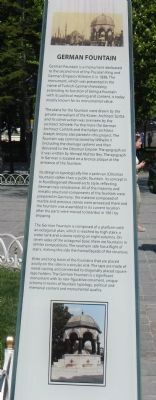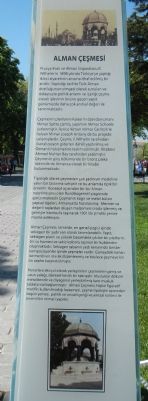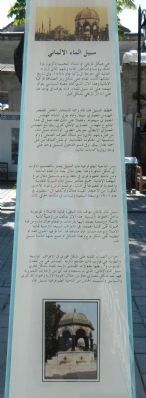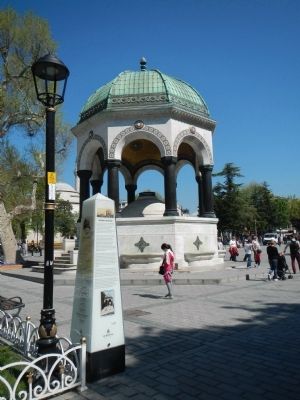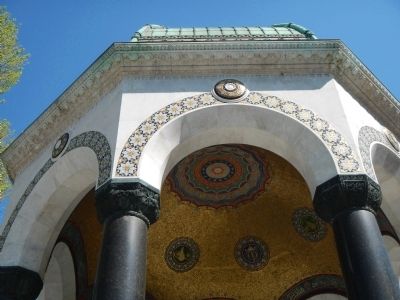Binbirdirek in İstanbul in Fatih, Turkey — West Asia or Southeast Europe
German Fountain
Alman Çeşmesi
German Fountain is a monument dedicated to the second visit of the Prussian King and German Emperor Wilhelm II in 1898. The monument, which was presented in the name of Turkish-German friendship, extending its function of being a fountain with its political meaning and content, is today mostly known for its monumental value.
The plans for the fountain were drawn by the private consultant of the Kaiser, Architect Spitta and its construction was overseen by the architect Schoele. Furthermore the German Architect Carlitzik and the ltalian architect Joseph Antony also parted in this project. The fountain was commissioned by Wilhelm (including the drainage system) and then delivered to the Ottoman Empire. The epigraph on it was written by Ahmed Muhtar Bey, The epigraph in German is located on a bronze plaque at the entrance of the fountain.
Its design is typologically like a şadırvan (Ottoman fountain) rather than a public fountain. its concept is in Rundbogenstil (Round-arch) style, reflecting German neo-renaissance (sic). All of the masonry and metallic structural components of the fountain were prepared in Germany; the material composed of marble and precious stones were processed there and the fountain was assembled in its current location after the parts were moved to Istanbul in l90l by shipping.
The German Fountain is composed of a platform with an octagonal plan, which is reached by high stairs, a water tank and a dome resting on eight columns. On seven sides of the octagonal base, there are fountains in similar compositions. The southern side has a flight of stairs, making this side the frontal facade of the structure.
Wide and long basin of the fountains that are placed axially on the sides is a circular sink. The taps are made of metal casting and connected to diagonally placed square taps holders. The German Fountain is a significant monument with its non-figurative ornament, unique scheme in terms of fountain typology, political and memorial content and monumental quality.
Turkish:
Prusya Kralı ve Alman İmparatoru II, Wilhelm'in 1898 yılında Türkiye'ye yaptığı ikinci ziyaretinin anısına ithaf edilmiş bir anıttır. Yapıldığı tarihte Türk-Alman dostluğunun simgesi olarak sunulan ve dolayısıyla politik anlamı ve içeriği çeşme olarak işlevinin önüne geçen yapıt, günümüzde daha çok anıtsal değeri ile tanınmaktadır.
Çeşmenin planlarını Kaiser'in özel danışmanı Mimar Spitta çizmiş, yapımını Mimar Schoele üstlenmiştir. Ayrıca Alman mimar Carlitzik'le İtalyan Mimar Joseph Antony de bu projede çalışmışlardır. Çeşme, II. Wilhelm tarafından (kanalizasyon giderleri dahil) yaptırılmış ve Osmanlı hükümetine teslim edilmiştir. Kitabesi Ahmed Muhtar Bey tarafından yazılmıştır. Çeşmenin giriş bölümünde bir bronz plaka uzerinde de Almanca olarak bir kitabe bulunmaktadır.
Tipolojik olarak çeşmeden çok şadırvan modeline yakın bir tasarıma sahiptir ve bu anlamda tipik bir ornektir. Konsept açısından bir tür Alman neorönesansı olan Rundbogenstil çizgisinde görünmektedir Çeşmenin kagir ve metal bütün yapısal öğeleri, Almanya'da hazırlanmış; Mermer ve değerli taşlardan oluşan malzemesi orada işlenmiş ve gemiyle İstanbul'a taşınarak 190l'de şimdiki yerine monte edilmiştir.
Alman Çeşmesi, temelde, en genel çizgisi içinde sekizgen bir şadırvan olarak tanımlanabilir. Yapıt, sekizgen planlı ve yüksek basamakla çıkılan bir platform, bir su haznesi ve sekiz kolonla taşınan bir kubbeden oluşmaktadır. Sekizgen tabanın yedi kenarında benzer kompozisyonlar içinde çeşmeler vardır. Güneydeki kenarı ise merdiven olarak düzenlenmiş ve böylece çeşmeye bir on cephe kazandırılmıştır.
Kenarlara aksiyal olarak yerleştirilen çeşmelerin geniş ve uzun yalağı, dairesel kesitli bir teknedir. Musluklar döküm metaldendir ve diyagonal yerleştirilmiş kare musluk ablalarına bağlanmıştır. Alman Çeşmesi, hiçbir figüratif motifin kullanılmadığı bezemesi, çeşme tipolojisi açısından özgün şeması, politik ve anısal içeriği ve anıtsal kalitesi ile önemli bir mimari yapıttır.
Arabic: To read the Arabic text, click on the Arabic image to enlarge it.
Erected by Istanbul Büyükşehir Belediyesi (Istanbul Metropolitan Municipality).
Topics. This historical marker is listed in these topic lists: Charity & Public Work • Government & Politics. A significant historical year for this entry is 1898.
Location. 41° 0.425′ N, 28° 58.597′ E. Marker is in İstanbul, in Fatih. It is in Binbirdirek. Marker is on Atmeydanı Caddesi, 0 kilometers Kabasakal Cadde. Touch for map. Marker is at or near this postal address: Atmeydanı Cd 17 D, İstanbul 34122, Turkey. Touch for directions.
Other nearby markers. At least 8 other markers are within walking distance of this marker. Mausoleum of Sultan Ahmed I (within shouting distance of this marker); Firuz Aga Mosque (about 90 meters away, measured in a direct line); St. Euphemia's Martyrion (about 120 meters away); Serpent Column (about 120 meters away); Cistern of Philoxenos (about 150 meters away); The Milion Stone (about 150 meters away); Obelisk of Theodosius (about 180 meters away); Million (about 180 meters away). Touch for a list and map of all markers in İstanbul.
More about this marker. The German Fountain is located at the northeast end of the Hippodrome.
Credits. This page was last revised on February 13, 2023. It was originally submitted on June 24, 2015, by Barry Swackhamer of Brentwood, California. This page has been viewed 553 times since then and 39 times this year. Photos: 1, 2, 3, 4, 5. submitted on June 24, 2015, by Barry Swackhamer of Brentwood, California. • Andrew Ruppenstein was the editor who published this page.
